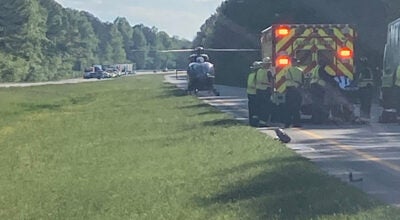Battleground: Suffolk
Published 10:12 pm Monday, April 8, 2013
To mark its 150th anniversary, from Wednesday through May 4, the Suffolk News-Herald will feature a multi-part series by Suffolk historian Kermit Hobbs detailing the 23-day Siege of Suffolk.
The character of the sleepy little town of Suffolk already had changed by April 9, 1863.
Eleven months of occupation by Federal troops had changed the town’s landscape and had resulted in a fearful existence for those residents who had ignored an evacuation order by the Confederate Secretary of War, William W. Randolph, on May 10, 1862.
A mere two days after Randolph’s order for Confederate troops to decamp from Norfolk and Suffolk, four companies of the 1st New York Mounted Rifles rode into Suffolk.
“Conditions among the civilians changed drastically with the arrival of the Union forces,” writes Nansemond Historical Society board member Kermit Hobbs in “Storm Over Suffolk.”
“The occupying troops did not hesitate to occasionally tear down and burn rail fences or raid henhouses for quick and easy meals.”
But the town that Brian Steel Wills, writing in his book “The War Hits Home,” calls “a small rural community” with “brick and wooden buildings fronting tree-lined streets” had changed even before the Federal troops had arrived.
It had been a peaceful place, with two railroads passing through town — the Norfolk and Petersburg and the Seaboard and Roanoke, providing trade between the port of Norfolk and Richmond.
Commerce also came by way of oystering and fishing on the Nansemond River and in the surrounding counties of Southampton, Isle of Wight and — long before it merged with Suffolk — Nansemond, from corn, peanuts, hogs and other agricultural commodities.
Other mainstays of the local economy, owing to the town’s proximity to the resources of the Great Dismal Swamp, included the manufacture of tar, turpentine, barrel staves and shingles.
But things had begun to change by the end of spring in 1861. “The sleepy little town … was awakening to the sounds of marking and drilling as it was transformed into a vast military camp almost overnight,” Wills writes.
A combined 1,500 men raised for the Confederacy from Suffolk and Nansemond County had been assigned to various posts in town. Soldiers who had enlisted for martial glory soon found themselves mired in “constant” drilling.
“I am pretty worn out with the drilling,” John T. Hambrick wrote home to his wife, according to Wills. “Nine hours in the sun is no small matter.”
Hobbs writes that after these soldiers for the South had ventured off to meet an uncertain fate in battle, “Suffolk was left with a population of woman, children, and elderly men.”
Nevertheless, stores remained open, slaves still worked the fields and warehouses, and Georgia and South Carolina regiments in town for basic training “were a comfort to the civilian population.”
The mood swung dramatically, though, with Union Gen. George B. McClellan’s breakthrough at Yorktown, which, Wills writes, “clear(ed) the way for his advance up the Peninsula toward Richmond.”
If the people of Suffolk had felt themselves safe because of the presence of Confederate troops training in town, the evacuation of those troops would change everything.
Hobbs cites a letter penned by Mattie J. Prentis in which she complains of Yankee officers threatening to jail families and pull down their houses for singing Southern songs like “Bonnie Blue Flag” and “Dixie’s Land.”
“The more I see the Yankees, the worse I hate them,” Prentis wrote.
But the Confederates were set on harassing their enemy’s new position, and having fallen back to west of the Blackwater River, and now under General Roger A. Pryor, they launched an unsuccessful attack — what became known as the Battle of Deserted House — after assembling at the intersection of the two railroads overnight on Jan. 29, 1863.
Food was a precious commodity for the troops, and the Siege of Suffolk, as it would become known to history, was itself at least in part precipitated by the need to feed the southern troops.
Gen. James Longstreet, commanding the Army of Northern Virginia, was given permission to clear the area of purchasable supplies. Whether to attack the town was “Longstreet’s decision when the time came,” according to Hobbs.
One hundred and fifty years ago on Thursday, a freed slave reported the advance of the Confederates to a signal post outside Suffolk.
While relaying the intelligence to Gen. Peck, commander of Union forces in Suffolk, an officer on duty reportedly saw “cavalry soldiers coming in at a furious rate, riding barebacked.”
The Federals burned homes as they drew in their pickets, Hobbs writes, leaving many Suffolkians with only the clothes on their backs and no shelter.
Fearing capture, Peck ordered new forts and batteries, and during the campaign, Federal forces in Suffolk almost doubled to 29,000, with new arrivals daily.
Hobbs cites a letter by Emma Ferguson: “The Yankees now become stricter than ever,” she wrote. Their civilian prisoners were “completely cut off from the outer world, they were allowed few privileges and no means of acquiring any information.”
The siege ended on May 4 after Longstreet’s 20,000 troops were requisitioned to help stop a Federal campaign on Richmond.
The 23 days between that Confederate advance on a signal tower and the movement of Longstreet’s troops to Richmond have come to be known as the Siege of Suffolk, and they marked an important, though sometimes forgotten, part of the city’s history.
Tomorrow: Part 1: The stage is set.






